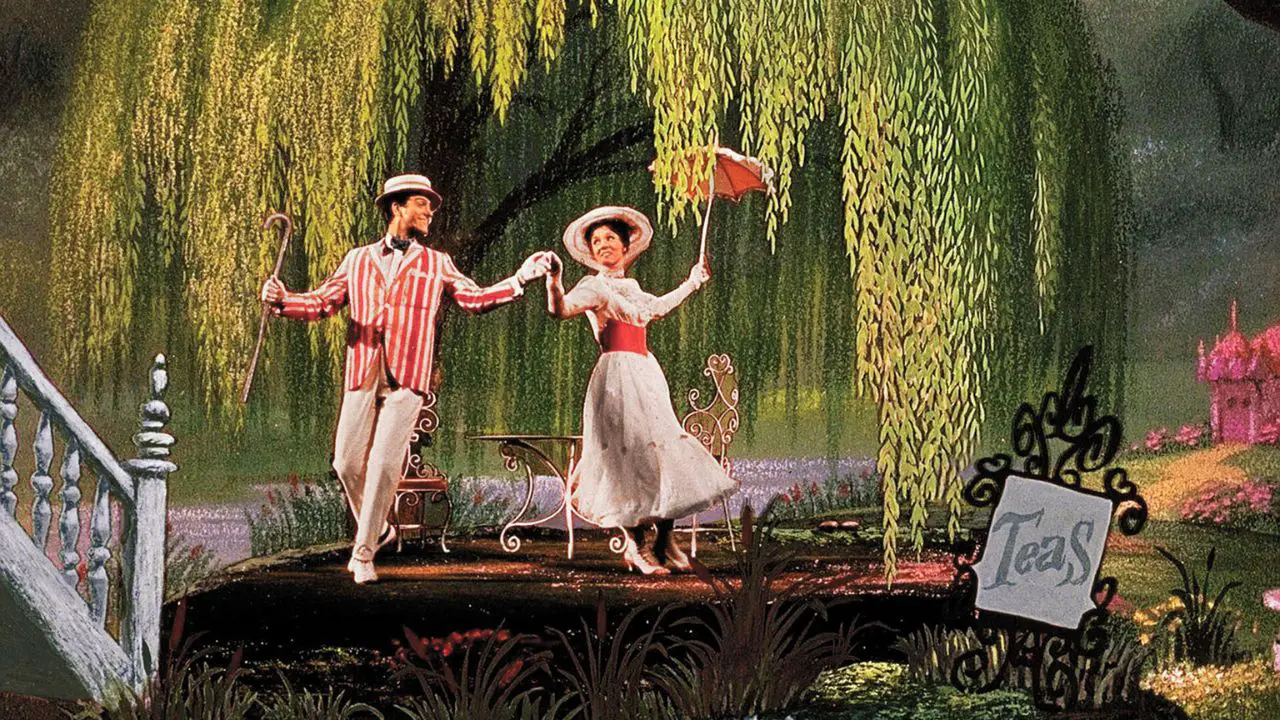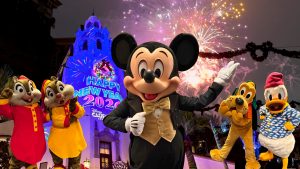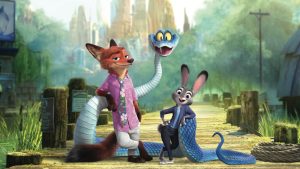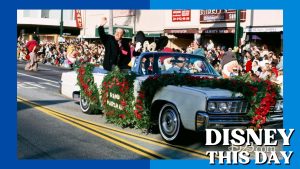Sixty years ago today, Walt Disney brought to life one of literature’s most beloved and delightful heroines: Mary Poppins.
Mary Poppins (1964) would not only become one of the world’s most delightful motion picture spectacles, winning multiple Academy Awards® (including Best Actress for Mary Poppins herself, Disney Legend Julie Andrews), but it would go on to showcase the unique joy, innovation, and magic that has come to define The Walt Disney Company.
To celebrate the anniversary of Mary Poppins — a film that has been critically hailed as one of Walt Disney’s crowning accomplishments and is beloved by generations — the Walt Disney Archives proudly presents a collection of iconic props, documents, and artifacts from the musical fantasy.
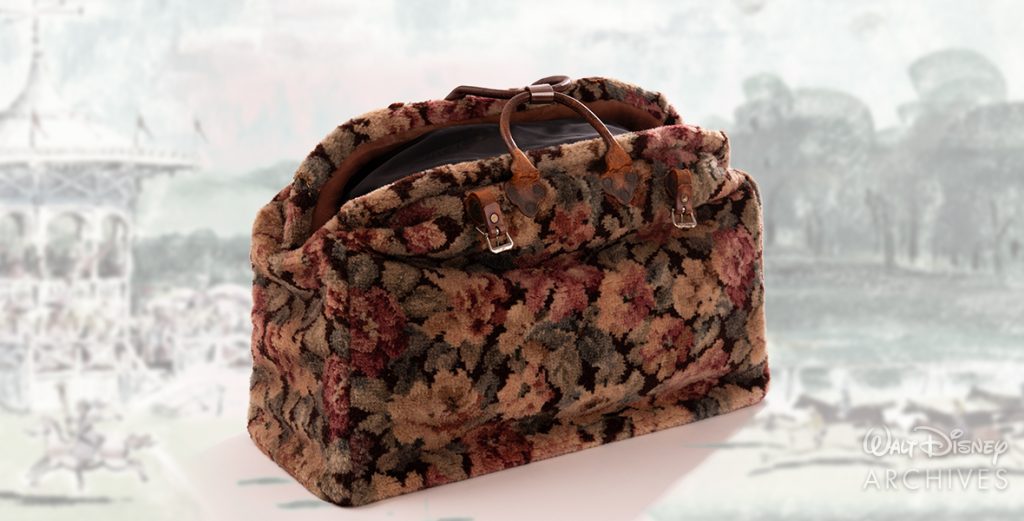
One of the most awe-inspiring movie props — the charmingly mysterious carpet bag — is seen above.
Darlene Fogg — Senior Secretary with the Archives — remembers going to see Mary Poppins during its 1980 theatrical re-release, commenting that the title character was unlike any she had ever seen before and that everything “from the scenery to the music, right down to the special magical carpet bag” was perfect.
“I am so thrilled that the Walt Disney Archives has the carpet bag in [our] collection,” she says, “along with other precious pieces from Mary Poppins.”
Covering more than 100 years of storytelling, the Archives’ collection is a testament to Walt’s enduring legacy, housing countless historical objects, each with a unique story, that are carefully preserved in unassuming, secret locations in and around the company’s headquarters in Burbank, California. Over 500 objects related to the 1964 film are safeguarded in the vaults of these locales.
A Marvel of Creativity and Ingenuity
The production of Mary Poppins was a marvel of creativity and ingenuity.
Some of the most lavish sets ever seen in a Walt Disney production were designed and housed across four sound stages on The Walt Disney Studios lot. The Cherry Tree Lane and nearby park set filled an entire stage and was a testament to the filmmakers’ attention to detail. Every cherry blossom, made of materials imported from France and Portugal, was mounted into place by hand, creating a stunning (and memorable) visual effect.
A 360-degree cyclorama was painted to surround the entire set, adding depth and dimension to the lovely London sky. These settings were designed and created by art directors Carroll Clark and William H. Tuntke, with two-time Academy Award winner Emile Kuri and Hal Gausman handling the set decoration. Noted English designer Tony Walton created colorful costumes and was a design consultant for the overall production.
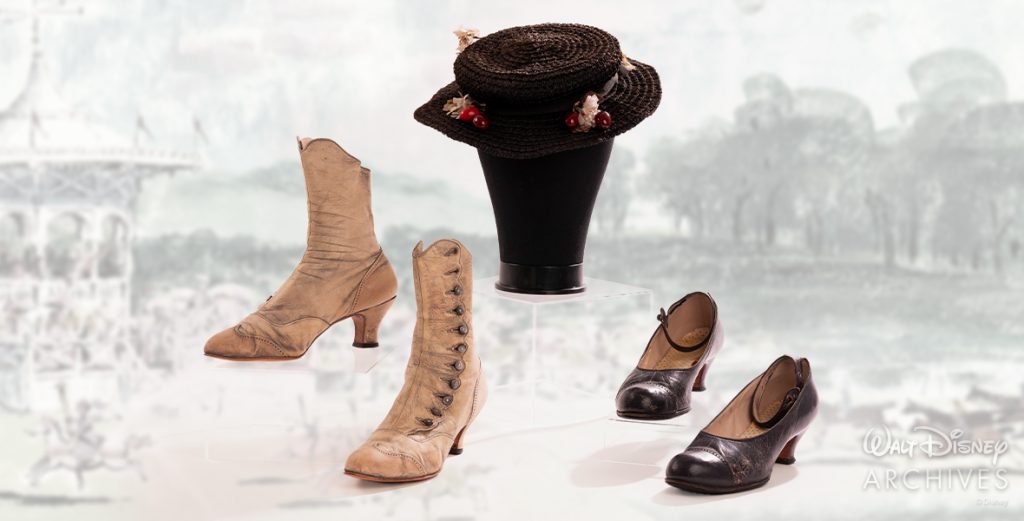
Pictured above are several items from Mary’s wardrobe that Walton and his team designed: Mary’s classic black hat, with bright red cherries and flowers; her “Jolly Holiday” boots; and her arrival shoes. Becky Cline, Director of the Walt Disney Archives, recalls a time in her career when she received frequent phone calls from Disney enthusiasts who inquired how many cherries were on Mary’s hat. (If you’re wondering, the answer is eight.)
Some passionate Poppins experts may notice that Mary’s “Jolly Holiday” boots look a bit different than how they first appeared on-screen in the pastel English countryside. These shoes were indeed worn by Andrews but were later painted white and used in the 1968 Disney musical The One and Only, Genuine, Original Family Band, where they were worn by actress Lesley Ann Warren.
A Monumental Work of Artistry
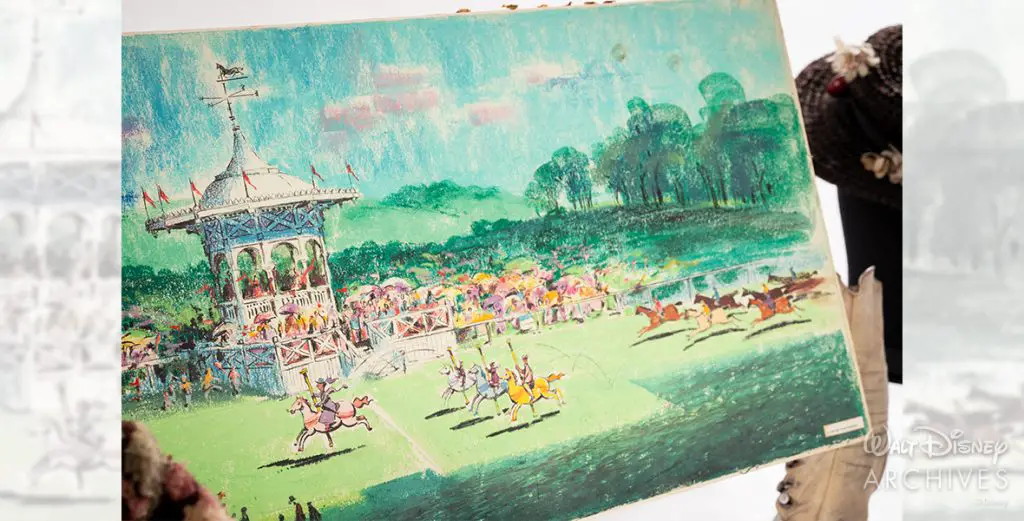
Speaking of the pastel English countryside… a team of remarkable studio professionals collaborated to ensure Mary Poppins was a monumental work of artistry.
The rich and fantastical animated world they created for the film’s “Jolly Holiday” segment acts as a whimsical break from the characters’ everyday London schedule, offering an inviting, impressionistic journey into one of the sidewalk drawings by Bert (played by Disney Legend Dick Van Dyke).
The production art above, which depicts the iconic horse race sequence, is a perfect example of the talent, skill, and imagination of art director Carroll Clark and artists (and Disney Legends) Xavier “X” Atencio, Don DaGradi, Bill Justice, and Peter Ellenshaw. This colorful artwork is among hundreds of concept drawings, exploratory sketches, matte paintings, and other visual art from the production carefully preserved in the Walt Disney Archives.
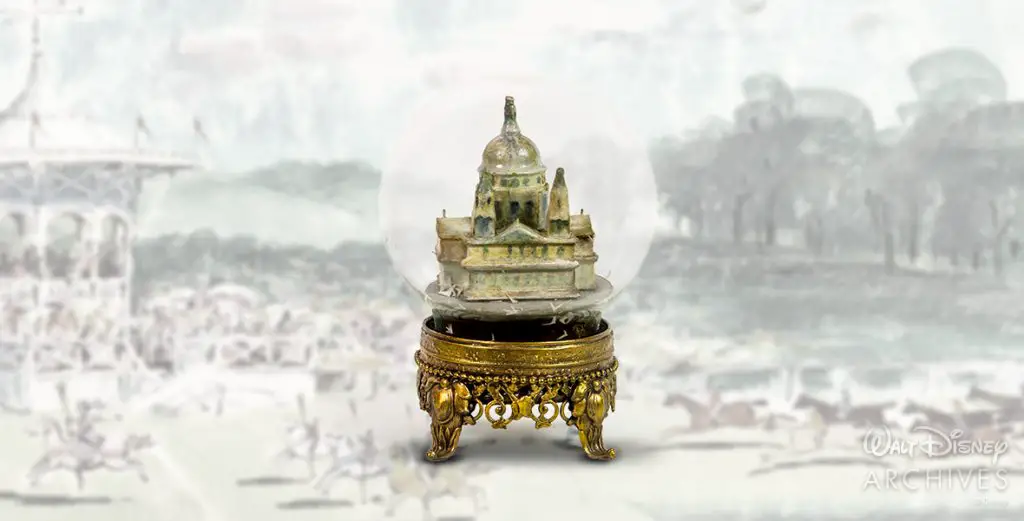
Above is a glimpse at one of the most beloved props in the Archives collection, and from a pivotal scene in the film: a moment when Mary teaches the Banks children a precious life lesson as she sings to them the special lullaby “Feed the Birds” (written by Disney Legends Richard M. Sherman and Robert B. Sherman).
The story of how this snow globe, featuring St. Paul’s Cathedral, found its way to the Archives is remarkable.
One day, years after the film’s release, the head janitor at the Disney studio found the object in the trash. Thinking it was interesting, he saved it and displayed the snow globe in his office. In the early 1970s, when a then newly hired Dave Smith (founder of the Walt Disney Archives and Disney Legend) saw it on the janitor’s shelf, he correctly identified it as the one from the film.
The legendary snow globe is currently on display at Disney100: The Exhibition in Kansas City, Missouri.
The Historic Premiere
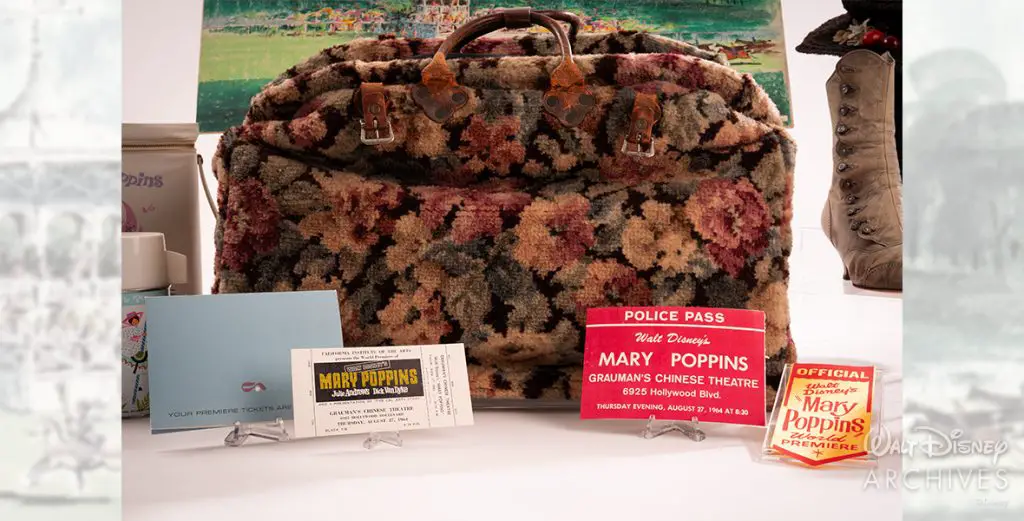
Mary Poppins famously premiered at Grauman’s Chinese Theatre on Thursday, August 27, 1964. Songwriter Richard Sherman recalled, “It was one of the most amazing experiences of my life… After four years of working on this film, I was floating on clouds.”
The Archives collection preserves several unique pieces from the historic premiere, including this ticket and envelope; an official lapel ribbon worn by premiere staff; and a police pass.
It took seven months to plan for such a lavish and special premiere, and this one would be Walt’s first massive Hollywood event since the groundbreaking Snow White and the Seven Dwarfs in 1937. The evening also served as a benefit for CalArts, a groundbreaking school being developed to train a new generation of artists. Before Walt’s masterwork was unveiled to the invited audience, a 15-minute film, The CalArts Story, narrated by famed actor Sebastian Cabot, was screened.
Then, the opening credits for Mary Poppins rolled for the first time.
Richard Sherman recalled, “We were all praying it would be a success. We thought it was good, but maybe we were just [biased]. Everybody was just glued to that screen. They laughed at all the right places. After ‘Step in Time,’ there was thunderous, screaming applause… [and] when it was over, everybody stood up en masse and applauded. And they continued standing for five minutes. Women were wiping their eyes. [Co-producer and Disney Legend] Bill Walsh leaned over and winked. I looked over at Walt, and he was all smiles. He felt so good. What a wonderful thing for the creators of the film to feel and see.”
A Testament to Walt Disney
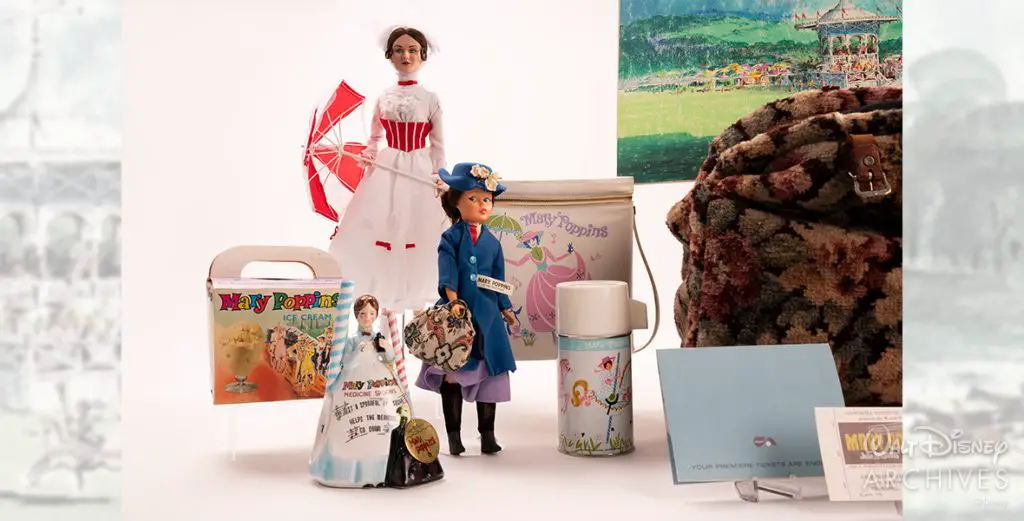
In its initial release, Mary Poppins was a box office hit and received 13 Academy Award nominations, resulting in five wins. The love for Mary Poppins continues to soar all these years later, and the Archives houses an impressive array of representative merchandise produced from the film’s release through the present.
Merchandise played a vital role in the marketing of Mary Poppins the world over, as Disney licensed the film’s characters to a variety of companies for use on a plethora of product. On the heels of the film’s 1964 release, Poppins’ magical prop carpet bag left the Disney studio as part of a promotional giveaway by Kraft Chocolates.
The first prize was the carpet bag filled with $10,000 in cash. The winners apparently valued the money more than the bag, which reportedly sat in an attic for some 40 years before being correctly identified and finding its way to the Walt Disney Archives.
Pictured above are several notable pieces from the Archives’ collection of merchandise. Two Mary Poppins dolls—one more vintage, in a stylish blue jacket with matching hat, and a more recent one sporting her iconic “Jolly Holiday” look—showcase the differences and looks across generations.
Sixty years later it’s clear that no other studio but Disney could have created a film like Mary Poppins. Its continued popularity over the last six decades is a testament to the dreams of Walt, the company he built, the happiness the film holds for millions of people around the world.

